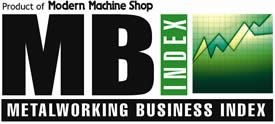November Index Reflects Contraction Again
However, compared with 1 year ago, the index grew 0.4 percent.

With a reading of 48.7, the Gardner Business Index showed that the production machining industry contracted at a relatively moderate rate for the second month. However, compared with 1 year ago, the index grew 0.4 percent. It contracted in October. The annual rate of change continued to grow at a strong rate, but it decelerated for the second month in a row.
New orders contracted for the second month in a row. The trend in new orders has steadily declined since January. Production expanded for the 11th consecutive month. It has steadily declined since March, but the down trend has not been as steep as it was for new orders. Backlogs have contracted 4 of the last 5 months. They contracted at their slowest rate since September 2013. Compared with October, the backlog index improved slightly. But, compared with 1 year ago, the backlog index contracted for the second month in a row. The annual rate of growth in backlogs is still very strong. Therefore, the trend in backlogs indicates significant increases in capacity utilization and capital equipment consumption this year. But, capacity utilization should see its peak rate of growth in the first or second quarter this year. Employment increased at its fastest rate since June 2014. The contraction in exports slowed somewhat in November, although the dollar continued to strengthen. Supplier deliveries have lengthened at a significantly slower rate the last couple of months.
While material prices were increasing at significantly accelerating rate earlier this year, the previous 4 months have seen a lower rate of increase. Material prices are increasing at their slowest rate since March 2014. Prices received have been virtually flat the previous 2 months. Future business expectations rebounded sharply in November. They were at their highest level since June 2014.
Shops with 50-99 employees expanded at the fastest rate by far in November. They have been growing at a significant rate since October 2013. Facilities with 100-249 employees contracted for the second month in a row, while shops with more than 250 employees expanded slightly after contracting in October. Shops with 20-49 employees contracted for the second time in 3 months. These shops have been the most significant reason for the lower index the last few months. Shops with fewer than 20 employees contracted once again.
The Northeast was the only region to grow in November. It had contracted the previous 2 months. The North Central – East contracted for the first time since December 2012. The North Central – West and Southeast contracted for the second month in a row. The West contracted at its fastest rate since August 2013.
Future capital spending plans for the next 12 months increased 14.1 percent compared with 1 year ago. This was the third month in a row that the month-over-month rate of change grew more than 10.0 percent. While the annual rate of change grew for the second month in a row, the rate of growth was a little slower this month.



